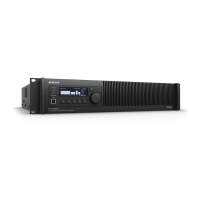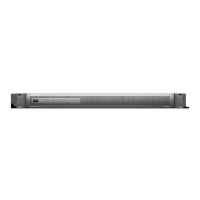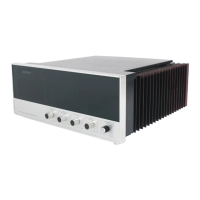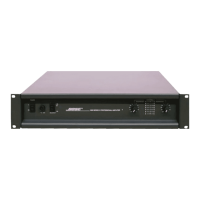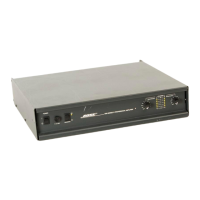Page 12 Installation and Safety Guidelines English
Installation pro.Bose.com
Output Power Configurations
The PM8500 amplifier allows output power to be allocated between 2 to 8 output channels and allows for both low-impedance and
high-impedance (70V and 100V) loudspeaker loads. To illustrate the possible output configurations, the menu display for CH 1 output
configurations are presented below:
CH 1Menu Display Channels Effected Power Rating Intended Loudspeaker Load Max Channels
MONO CH 1 500 W @4Ω 2 to 16 ohms 8
CH1+2 V-Bridge (Low-Z) CH 1 and CH 2 1000 W @8Ω 4 to 8 ohms 4
CH1+2 V-Bridge (70V) CH 1 and CH 2 800 W @70V 70-V “constant voltage” lines 4
CH1+2 V-Bridge (100V) CH 1 and CH 2 1000 W @100V 100-V “constant voltage” lines 4
CH1+2 I-Share (Low-Z) CH 1 and CH 2 1000 W @2Ω 2 ohms 4
CH1+2+3+4 Quad (Low-Z) CH 1, CH 2, CH 3, CH 4 2000 W @4Ω 2 ohms 2
CH1+2+3+4 Quad (70V) CH 1, CH 2, CH 3, CH 4 1600 W @70V 70-V “constant voltage” lines 2
CH1+2+3+4 Quad (100V) CH 1, CH 2, CH 3, CH 4 2000 W @100V 70-V “constant voltage” lines 2
Note: For I-Share and Quad Bridge Modes, changing the output configuration will automatically place the unit in Standby Mode to allow
different loudspeaker cable connections to the rear-panel output terminal blocks. Additionally, the menu displays are context-sensitive;
not all combinations are possible for all channels.
The front-panel output meters automatically change display width to identify the various output configurations during normal operation.
The 4 possible output configuration meter displays are presented below (note the mixed mode display has many other possible
combinations):
Figure 5. Front-Panel Output Meters by Configuration
Mono (8 x 500 W) V-Bridge or I-Share (4 x 1000 W
Quad Bridge (2 x 2000 W) Mixed Mode (varies by configuration)

